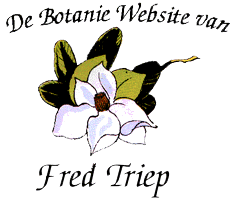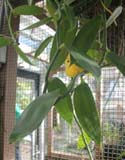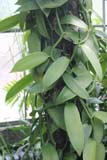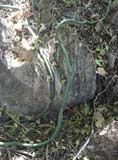|
|
||
A revised version of this article was published before in the "Hortus Magazine" (December 2012) of the "Botanical Garden of Amsterdam"
by Fred Triep
| Any idea where the vanilla pod comes that you use for cooking? And the vanilla flavored custard for example? We owe this spice to an orchid that has a close relationship with fungi. And a 12 - year old slave who nearly two centuries ago invented a new form of pollination of this orchid. |
|
The vanilla orchid (Vanilla planifolia)
is the supplier of vanilla. This orchid grows in Florida, Mexico, West Indies,
Central America and northern South America. The orchids (Orchidaceae)
form a family of eight hundred genera and twenty-two to thirty-five thousand
species. It is the largest family of the plant kingdom. Orchids are among other
things characterized by a two-sided symmetrical flower, which consists of three
flower petals and 3 sepals. The middle petal is different in shape and enlarged
to a lip.
In addition, all orchids have a symbiotic relationship with
fungi, which are called mycorrhiza. Without the presence of these fungi, the
seeds of this plant family do not grow into mature plants. The fungi make sure
that the orchid can take up minerals. The fungi benefit from this relationship,
because they can use the organic substances made by the orchid. We call here of
a mutual symbiotic relation, a symbiosis where both organisms benefit. The
cooperation with fungi in orchids is very intimate; the hyphae grow through the
bark of the roots.
Air Roots
The orchid genus Vanilla contains hundreds of different species, living
in tropical and subtropical regions throughout the world. They are epiphytes,
which uses trunks as a substrate for their growth. The seeds germinate yet
mostly on the ground, whereupon the orchid climbs
along a tree. At a later stage, the contact with the ground disappears
because aerial roots take up than water and minerals. The plant has become a
true epiphyte. Such an epiphyte is called a hemi-epiphyte.
The flowers appear
in spring in a short raceme. The tepals are green to pale yellow in color. The
middle petal is shorter and rolled into a cylinder with a wavy margin. The
flowers bloom very short, within 24 hours they wither.
Slave
The fruits develop after pollination by the mountain bee (Melipona beechii). Because this bee occur only in the vicinity of
the original growth place of V. planifolia,
vanilla could not produce in the 17th and the 18th century outside Central
America. In 1841 the 12-year-old slave Edmond Albius on Réunion developed a
technique, to wipe aside the partition between the stamens and the pistil (the
rostellum) with a stick or a beveled bamboo leaves, whereupon the pollination
could take place with the thumbs. This technique could from that year the
vanilla orchid in other tropical countries used for the production of vanilla.
This technique is now also used in the initial growth area of V.
planifolia, because the yield through pollination by bees is too low.
Vanilla originate from the unripe fruit of
Vanilla planifolia or of the related
species V. x tahitensis (a hybrid form
in the South Pacific) and V. pompona (West Indies) by fermenting them. After about six months
of ripening, the fruits are harvested and the cells of the pods are killed and
damaged by cooking, freezing, cutting open or heating in an oven.
The most
common method is the Bourbon method of Madagascar and the islands around it,
where the fruits are held some time in boiling water. Then the fruits are packed
for 7 to 10 days in wool at 45 to 60 degrees Celsius and high humidity. The pods
are becoming black during this treatment, while in the pods enzymatic
conversions occur by which glucovanillin is converted to glucose and vanillin.
The enzymes which are responsible for these conversions, are already found in
the fruit, but are normally separated of the glucovanillin. By killing the
cells, the enzymes can react with the raw material of vanillin. During the
fermentation process many other aromatic substances are created. Hereafter the
fruit are dried, to prevent them from rotting and moldy. The fruits are kept in
closed boxes between wax paper to preserve the scent.
Handiwork
The word vanilla derives from the Spanish word `vaina`, which means little pod. The Spanish conquistadors led by Cortez gave this name to this product. Vanilla is made from the pod-like fruit of the orchid. The fragrant substance vanillin is made in the fruits at ripening. This organic matter was isolated in 1858 from the fruits. It can also be created artificial from lignin, an organic compound from wood. But the synthesized vanillin lacks the 170 other chemicals that complement the flavor of vanillin from vanilla. This artificially created vanillin is used in 95% of the products with vanilla flavor, because natural vanilla is expensive. For the production of vanilla is much handwork required, the flowers must be pollinated manually within twelve hours after the opening and the fruit must be picked at the right time: when they change from green to yellowish green.
There are different types of vanilla on the market, the best known is the
Bourbon vanilla, which is produced with V.
planifolia in the Indian Ocean (Madagascar, Comoros, Réunion and Indonesia)
is produced. The Mexican vanilla comes from the area of origin of this orchid.
Tahitian vanilla comes from French Polynesia and is produced by the species
V. tahitensis. In 2008, DNA testing
proved, that this plant is a cross between two original Central American
species, namely V. planifolia and
V. odorata. The West Indian vanilla is
produced by V. pompona in the
Caribbean. The orchid species
V.tahitiensis and V.pompona have a
lower yield of vanillin than V. planifolia.
Nowadays most vanilla is produced in countries around the Indian Ocean. The
largest producers are Indonesia (60 percent), Madagascar (23 percent) and China
(9 percent). Mexico, the area where Cortez and his men ever discovered
'vanilla', provides only 2 percent of this spice.
Coca-cola
Producer soda Coca-Cola is the largest consumer of natural vanilla. When in 1985 the new flavor "New Coke" was introduced the economy of Madagascar collapsed. The reason was that in New Coke the cheaper synthetic substitute vanillin was used. The use of real vanilla drops off during this period by more than a half. The economy of the island again scrambled only after the new Coke was taken out of the assortment due to complaints from consumers.
Plants with leaves and plants without leaves
Most
species of the genus Vanilla have leaves. Some species from Africa,
Madagascar and Asia have lost their leaves. This is probably an adaptation to
dry conditions. The stems have here acquired the primary task of the leaves
toward photosynthesis. These plants have often also a groove along the length of
the stem, thereby making the stems looking C-shaped in cross-sectional
appearance. With this structure the stems can easily shrink under drought
conditions, without damage to the cells.
Vanilla in the Botanical Garden of Amsterdam
The vanilla orchid hangs in the Botanical Gardens of Amsterdam in the educational greenhouse / butterfly house, immediately after entering right behind the two doors. There is also a copy in the tropical part of the “Drie Klimaten Kas” (three climates greenhouse), but this plant is hard to find.
Literature
Vanilla in the Flora of North America @efloras.org
http://www.efloras.org/florataxon.aspx?flora_id=1&taxon_id=134375
Vanilla planifolia in the Flora of North America@efloras.org
http://www.efloras.org/florataxon.aspx?flora_id=1&taxon_id=134375
Vanilla - Wikipedia
http://en.wikipedia.org/wiki/Vanilla
Vanille-orchidee - Wikipedia
http://nl.wikipedia.org/wiki/Vanille-orchidee
Edmond Albius- Wikipedia
http://en.wikipedia.org/wiki/Edmond_Albius
C. Kalkman
Planten voor dagelijks gebruik- botanische
achtergronden en toepasingen
KNNV uitgeverij
K. Cameron
Vanilla Orchids – Natural History and Cultivation
Timber Press,
Portland, 2011
This page has been created on Friday 4 January 2013.
![]()
For additions or reacti
ons, send me an e- mail:
| Terug naar (return to): | Return to: |




